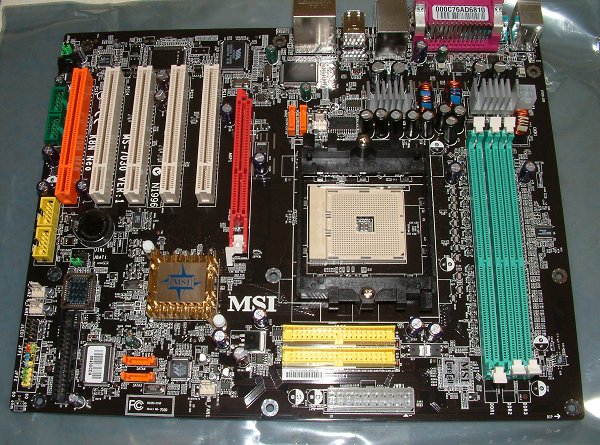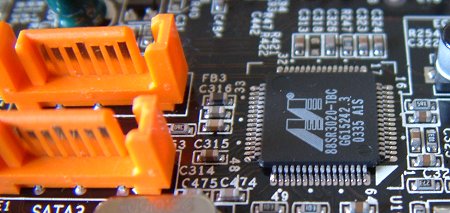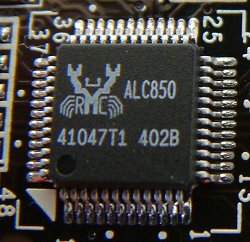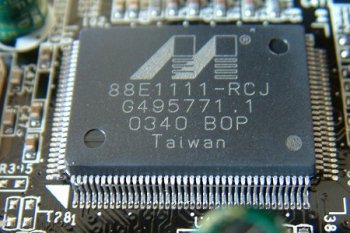Layout and features

We're normally left to reflect and evaluate motherboards that look increasingly like each other, right down to component placement and PCB colour. MSI's thrown the usual design book out of the window with the K8N Neo. On first glance, it looks like a photoshopped motherboard, such is the unusual location of ports and slots.
MSI's covered some of the hotter-running MOSFETs with passive heatsinks. This is steadily becoming the norm now, with EPoX following suit. The 4-pin 12v power connector is located just to the right of a heatsink. What's enabled MSI to re-jig the overall placement is NVIDIA's single-bridge chipset; there's no need to worry where the northbridge is going to be situated.
MSI's taken this opportunity to rotate the three DDR slots by 90 degrees. This completely removes the possibility of an AGP card blocking off the slots. Note that MSI specifies DDR400 operation for all three DIMM slots, even when run concurrently. Three is literally an odd number, as S754 boards house single-channel Athlon 64 processors. There's lots of room on the right-hand side, almost too much. MSI probably could have gotten away with a smaller PCB.
A bank of capacitors just above the socket could make installing large coolers an onerous task. The furthest one right gets ever so close to the first DDR slot, so just make sure that, when fumbling around with system memory, you push the DDR lock and not a capacitor. MSI's choice of IDE port location is pretty good. Both primary and secondary are easy to get to and disengage. Further good is to found with easy access to the main 20-pin power connector. The right-hand layout may be unusual but it works well.

nForce3 250Gb has heralded more SATA support than ever before. There's a couple of ports right next to the chipset, shown above, that are run through an external Marvell PHY (physical layer) and another couple, totally inherent to the chipset, to the right of the AGP slot. NVIDIA's also backed up the four possible ports with various RAID formations, and even allows for old primary and secondary PATA ports to get into the RAID act. That's perhaps why MSI didn't feel the need to add discrete storage controllers. A handy trait of all recent MSI motherboards has been coloured motherboard to-case pins. MSI uses coloured connectors for USB2.0 (from the nForce3 250Gb) and FireWire (from a discrete 3-port FireWire controller. 5 PCI slots is the norm for modern motherboards. MSI colours the left-hand one orange to denote that it can also accept communication cards. MSI's optional WLAN and Bluetooth devices take advantage of it.

VIA's audio ace is based on the Envy24 chipset. NVIDIA's was SoundStorm, as featured on the nForce2. However, NVIDIA's decided that AC'97 sound will suffice for its nForce3-series of boards. Motherboard manufacturers select an appropriate CODEC for each board's audio. MSI's gone with Realtek's trusted professional-level ALC850 CODEC. The name infers, correctly, that it's a 7.1-channel setup, which ties in with the kind of speaker package premium PCs are often associated with.

Marvell's gainfully employed to provide a low-cost physical layer to MSI's nForce3 250Gb's on-chip GbE. Transceivers are down to individual manufacturers and the tie-in they have with ASIC specialists. Strangely for a deluxe motherboard, the K8N Neo contains silkscreening for optional components and features. MSI's usually a company that tries its level best to include the proverbial kitchen sink on deluxe models.

A back panel that befits a deluxe board. Coaxial-Out will be appreciated by home cinema buffs. High-speed connectivity's in the form of a possible 4 of 8 USB2.0 and 1 of 3 FireWire400 ports, the others made up by the aforementioned coloured connectors.









